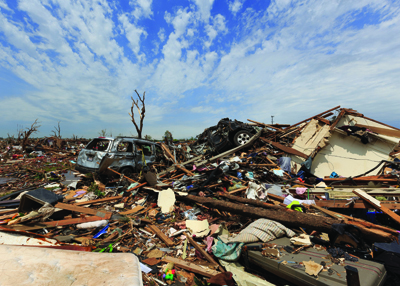When Broadcasting Saves Lives

The death and destruction caused by the massive tornado in Moore Okla., last month is a sad but timely reminder of the importance of preparation and the public safety role that broadcasters play.
It’s a macabre ritual in the Midwest that plays out every spring. And while meteorologists have made great strides in recent years in determining how these destructive forces are created, it means nothing if the publicdoesn’t get enough advance warning. And once again, as with so many disasters, broadcasters were on the front lines of providing that vital public service.
The tornado, which hit in mid-afternoon on Monday, May 20, was an EF5 on the “Fujita” scale and ended up killing 24 and injuring nearly 400 residents of the Moore area, a suburb of Oklahoma City. At one point during the tornado’s 39-minute life, winds from the 1.3 mile-wide twister reached 210 miles per hour. It ended up destroying more than 2,400 homes and businesses, causing between $1.5 billion to $2 billion in damages.
The residents of Moore, who suffered a similar destructive storm in 1999, were made aware that conditions were ripe for tornadic activity well in advance of the storm; the Storm Prediction Center had issueda moderate risk of severe thunderstorms in the early morning hours of May 20. Such advance warnings may be taken lightly in other areas of the country, but in tornado alley, the residents are not so sanguine.

Debris is all that is left of this neighborhood after an EF-5 tornado tore through the city of Moore Okla., May 20. And neither are area TV and radio broadcasters, who provided wall-to-wall coverage of the storm’s approach, destruction and aftermath. Many put their lives at risk providing essential information to viewers and first responders alike. Helicopter crews from local stations were among the first on the scene to document the massive destruction, the results of which someobservers compared to a nuclear bomb. Lives were saved as a direct result.
In today’s media-saturated environment, we’re all too familiar of the role that social media plays in relaying information, but as we’ve learned all too often, we play a dangerous game when such information is not filtered through reliable sources. And we’ve also learned that regardless of the ubiquity of cellular technology, such services are often useless in a disaster.
In Moore, broadcasting once again proved its vital importance in life-threatening situations. As one resident told a reporter, “I was watching News Channel 4 on my phone. And the last thing I heard before my cell reception went dead was ‘Get out of its way or get underground.’”
As this is being written, the Moore disaster has quickly faded, giving way to other more immediate news stories. But it will take months, perhaps years, for area residents to recover from the disaster. Suffice it to say, local broadcasters will be there to help citizens in their recovery.
Shortly after the disaster, KOCO-TV, the local NBC affiliate, broadcast a live concert to raise funds for the victims, one of many events and coordinated efforts to help in the recovery. To make a donation, visit https:// moore.recovers.org/
The professional video industry's #1 source for news, trends and product and tech information. Sign up below.
Tom has covered the broadcast technology market for the past 25 years, including three years handling member communications for the National Association of Broadcasters followed by a year as editor of Video Technology News and DTV Business executive newsletters for Phillips Publishing. In 1999 he launched digitalbroadcasting.com for internet B2B portal Verticalnet. He is also a charter member of the CTA's Academy of Digital TV Pioneers. Since 2001, he has been editor-in-chief of TV Tech (www.tvtech.com), the leading source of news and information on broadcast and related media technology and is a frequent contributor and moderator to the brand’s Tech Leadership events.

